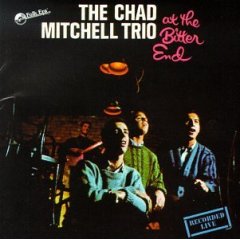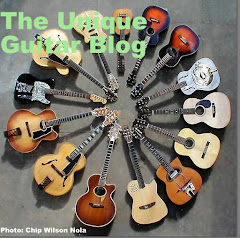 |
| Roger McGuinn 1961 |
Roger McGuinn was born in 1942 and grew up in the
James Joseph McGuinn, his given name went to The Latin School of Chicago. He became bitten with the music bug after hearing Elvis Presley sing Heartbreak Hotel.
He begged his parents for a guitar.
Other childhood influences include Gene Vincent, Carl Perkins and the Everly Brothers.
| Old Town School of Folk Music |
In 1957 McGuinn enrolled in Chicago’s Old Town School of Folk Music. It was there that he learned to play the five string banjo and got serious about playing guitar. By his graduation he was playing solo at various
 |
| The Chad Mitchell Trio |
His influences included several trio vocal groups including the Limeliters and the Chad Mitchell Trio, a group which he would later become a member.
| Bobby Darin |
McGuinn got a job playing guitar and singing background in Bobby Darin’s band. This job lead to him relocating to
| The Brill Building |
In 1962 Darin hired McGuinn with the thought in mind that Darin wanted to add some folk music to his career. These were the years that Folk Music had significantly gained in popularity. By mid 1963, Darin’s health began to fail and he retired from singing. He opened a songwriting and publishing office in
McGuinn also found work as a studio guitarist and that same year was backing up Judy Collins and Simon & Garfunkel on their recordings.
The rumblings of Beatlemania and the British Invasion were about to take place. Within less than a year the Beatles American tour would commence.
 |
| The Troubadour |
McGuinn traveled back to
This caught the attention of Gene Clark.
Eventually the duo found other like-mined folk/rock influenced member, Chris Hillman, David Crosby and Michael Clarke. The quintet began to perform at Los Angeles clubs. In January of 1965 they recorded the monster hit, Mr. Tambourine Man.
The Byrds' version was much different than what the songs writer, Bob Dylan, had put down on vinyl.
Their version began with an amazing four bar
guitar intro and outro that was played on a Rickenbacker 12 string guitar. This was a fairly recent instrument at the time and provided a very unusual sound. Part of that sound was
dependent on the engineers use of compression technology.
Members of the Byrds were dismayed by the fact that the only group member playing an instrument on the recording was McGuinn.
This was typical of most major recording sessions. Studio time was expensive and record companies wanted ‘product’ out as soon as possible. And this track was being done at Columbia Studios.
Members of the Byrds were dismayed by the fact that the only group member playing an instrument on the recording was McGuinn.
This was typical of most major recording sessions. Studio time was expensive and record companies wanted ‘product’ out as soon as possible. And this track was being done at Columbia Studios.
 |
| '65 McGuinn and producer Terry Melcher |
The other members of the Byrds sang back up.
 |
| Rickenbacker 360/12 string |
| Teletronix LA-2A Compressor |
"That is how I got my ‘jingle-jangle’ tone. I was able to sustain a note for three or four seconds.”
| The Byrds Eight Miles High |
This came in handy with the Byrds next hit, Eight Miles High. It was in this song that Jim McGuinn attempted to emulate John Coltrane’s disconnected jazz riffs. He didn’t think this could be accomplished without such sustain.
 |
| Rickenbacker 360/12 |
By combining a flat pick and metal finger picks…I discovered I could instantly switch from fast single-note runs to banjo rolls and get the best of both world."
 |
| The Byrds |
 |
| Roger McGuinn 2014 |
Jim sent in a list of ten names that had to do with airplanes and science fiction
As Roger was the one actual name and the 18th letter of the alphabet that air pilots use when talking on the radio, that was the name McGuinn chose.
 |
| Camilla and Roger McGuinn |
Since then Roger and his wife Camilla have become Christians.
 |
| 370/12RM |
McGuinn’s first Rickenbacker was a two pickup model 360-12 that had a beautiful blond finish. He was fascinated by the guitar George Harrison played in Hard Days Night.
McGuinn could not find a Rickenbacker 12 string that had the pointier cutaways and top trim. He purchased the only available model and used it through his Byrds career.
This guitar was stolen and when he replaced it with a similar instrument. He states that in later years it showed up at an auction and sold for $100,000.
 |
| JangleBox Compressor |
Paul Kanter of the Jefferson Airplane suggest using a Vox Treble Booster. This was one of the first generation sound enhancers. The unit was small and plugged into a guitars input.
McGuinn took the booster apart and installed in internally in his Rickenbacker. He states he tried other compression units, but could not get his sound until the Jangle-Box was invented.
 |
| Rickenbacker 370/12RM |
 |
| Roland JC 120 Jazz Chorus |
McGuinn currently uses the Jangle Box and a Roland JC120 amplifier to achieve his sound.
 |
| Rickenbacker 360/12 |
McGuinn does his own string changes and set up on his guitars. Changing strings on a Rickenbacker 12 can be an all day task. McGuinn has produced a video to show how he changes strings and also how he makes neck adjustments.
 |
| Martin D12-42RM |
Martin also came out with a very unique model for McGuinn called the HD-7. This is a historic dreadnought style 45 Martin that has 7 strings. The unusual thing about this instrument is that an octave ‘G’ string is added to give the sound of a 12 string guitar, but the ease and convenience of a 6 string guitar.
Roger frequently utilized single string runs to get his sound and this guitar does the trick. It too is no longer in production, but is still available through some major music stores.
He was using a Fender Mastertone banjo that was given to him by Fender guitars when they were about to be acquired by CBS. He traded it to a friend for an old banjo that was made using Vega and Ode banjo parts.
During his days with Sweethearts of the Rodeo, he used a Gretsch Country Gentleman. He did not think the Rickenbacker 12 would fit into Country Music.
He states that he owns two Rickenbacker ‘Light Show’ guitars, but no longer takes them on the road. He owns a number of Rickenbacker guitars. He also owns a Martin 00-21.
Now in his 70’s, McGuinn only tours to theaters and performing arts centers stating they are well equipped facilities. He travels with his wife and enjoys getting in touch with fans all over the country.
 |
| The Rock Bottom Remainders |
The band was established by writer, producer and literary agent Kathi Kamen Goldmark.
Over the years the Remainder has included among its members Dave Barry, Stephen King, Amy Tan, Cynthia Heimel, Sam Barry, Matt Groening, Greg Iles, Maya Angelou and Al Kooper.
Click on the links below the pictures for the sources. Click on the links in the text for more information.
©UniqueGuitar Publications







5 comments:
Marc, thank you again for putting together so much wonderful information on guitars.
Many of us are enormous fans of McGuinn, his music and guitars. Thanks for adding something new for us.
I had the pleasure to see him solo in the late 1990s or early 2000s in a small club. Arlo Guthrie was in town. Roger was not the greatest conversationalist in a small venue, but played some great solo music. The evening really came alive when Arlo joined him on stage. The banter was very funny, with many anecdotes about their friends, e.g. Bob Dylan, and some great harmonies. A very memorable concert.
Keep up the great work.
Thank you Joe. He sure influenced my playing.
~Marc
best blog i ever seen
Cars for sale
I'm a fan of Roger and The Byrds.
I wonder if anyone has heard Roger explain how he got the idea for the 7 string guitar with the octave G course. I have been considering making one since the mid-sixties when I saw Spider John Loerner playing one that he had made. He put a banjo peg on the headstock of his acoustic and used a tailpiece to anchor the string. He used it on the "Blues, Rags & Hollers", "Lots More Blues Rags & Hollers" and "Return Of Koerner, Glover & Ray" albums during the "Great Folk Scare". Since anyone who was properly fanatical would have been familiar with Spider John, I figured that this must be where he got the idea. Has anyone ever asked him? It seems odd that no one seems to mention Spider John when the seven string guitar is mentioned.
In order to save you time and effort, a skilled professional resume writer will review your resume and make any necessary changes on your behalf. If you want to learn more about creating a visually appealing and well-structured resume to show to a potential employer, you might consider hiring a professional resume writing service. A well-written, well-structured, and aesthetically appealing resume is something you may get from a professional resume writing service. Professional resume writing services can help you create a resume that is easy to read, easy to follow, and visually attractive. There are professional resume writers that can assist you in creating an eye-catching resume that will wow potential employers. They may also be able to assist you in drafting a cover letter to go along with your resume. They may also be able to provide suggestions for your cover letter. Consider using a resume writing service like SkillHub to help you with your CV and cover letter. You can find out more about this decision in this article. It's not only your resume and cover letter that a resume writer can help you with; they can also aid in the writing process of your resume and cover letter for the primary employer that requested your resume. Depending on what assistance you need, you might pay a different charge, which can range from merely updating your resume and CV to entirely rebuilding your professional image from the ground up.
Post a Comment